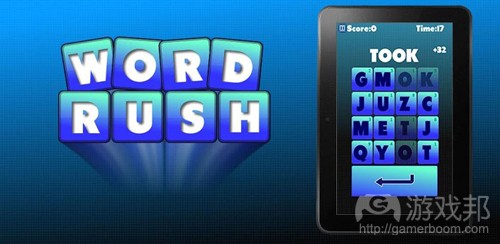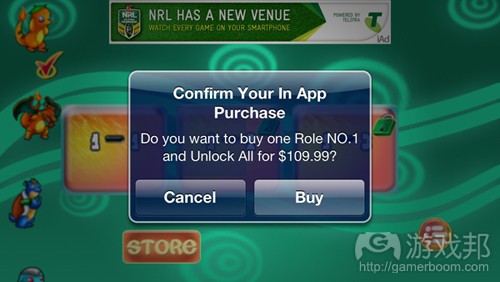分享抢占苹果应用收益排行榜的技巧(1)
作者:Jens Peter Jensen
进入苹果应用商店的收益排行榜是许多游戏开发者的梦想。有些人可能坚信,只要游戏的设计出彩、制作精良,就能打入收益排行榜。这是一个普遍的误解:关键不是做出了不起的游戏,而是做出正确的游戏。以下是我们在定位“正确的游戏”时得到的结果:(请点击此处阅读本系列第2篇、第3篇)
什么游戏是“正确的”?
为了便于展开讨论,我们先撇开这个事实——-好游戏是一个非常难懂又主观的概念。我们不要讨论“好的、坏的、糟的”游戏,至少现在还不行。毕竟,很难说什么样的游戏才是好的,即使我们通常以销量、下载量和收益作为“好的游戏”的指标。
从收益排行榜上看,似乎可以看出,成功并不只是做出一款好的或了不起的游戏,更多地是做出一款正确的游戏。有太多好游戏没有进入收益排行榜的前100名。如果你看看App Annie的收益排行榜,你最先注意到的可能是,只有17%的应用是付费的,而其他的都是免费的。那说明正确的游戏的模式并不是付费的,而是免费的。虽然以下数字仅是5月30日的,且排行榜每个小时都频繁地更新,但根据统计,进入收益排行榜前100名的免费游戏比例基本上介于85%到90%。
另一个值得注意的有趣现象是:5月30日当天,免费游戏《Word Rush?》在美国是下载排行榜上的第15名,但它并没有进入收益排行榜的前500名。那似乎暗示了,仅有高人气并不意味着它就是正确的游戏。《Word Rush?》不是个例——通常来说,下载排行榜与收益排行榜并不成对应关系。当然有些游戏在两个榜单上都排上名,但显然,下载量大并不是进入收益排行榜的必要条件。进入下载排行榜并不能保证也出现在收益排行榜上。
积极的赢利策略
有些游戏能进入收益排行榜正是因为它们本来就是为了收益而被设计出来的。当然有例外,比如口袋版《我的世界》。但绝大部分入榜的游戏就是为了挣钱,这样的目标意味着它们必须采用所谓的“积极的赢利策略”。
在这种情况下,使游戏挣钱的其实并不是游戏本身,而是被高超地结合到游戏中的赢利策略。这种“在赢利机制中内置游戏”的最成功的结果就是,玩家体验仍然是完美的、有趣的;最失败的结果就是,玩家觉得游戏抢钱的行为太公然,破坏了游戏体验。无论是哪种结果,目标都是一样的,让玩家掏钱。
这听起来似乎非常势利,但为了进入收益排行榜,游戏设计必须与赢利策略紧密结合。游戏和赢利必须完美融合,这样玩家体验才不会被二者的结合干扰或破坏。在这方面,《Candy Crush Saga》是最优秀的榜样之一,它的赢利策略执行得非常隐藏和自然,以至于玩家心甘情愿地掏钱。
至于积极的赢利策略执行不好的,反面案例非常多,但没有一个做得比《Super Monster Bros》更糟糕的。在苹果应用商店中,它也是经常公然抄袭其他游戏的代表。这款游戏后来被撤出应用商店,所以你不可能再试玩它了。
积极的玩家开发策略
收益排名前100的游戏通常都有非常积极的赢利策略,这是一个显著的趋势。但《Super Monster Bros》还告诉我们,光有积极的赢利策略是不够的。
为了进入收益排行榜前几名,到目前为止我们发现你必须使用免费模式和积极的赢利策略(最好采用,但不是必须的,以温和的方式)。
你还需要玩家,数百万的玩家。那意味着你其实需要一种玩家开发策略。主要有两种:
1、借助另一款玩家数多的游戏(花钱买交叉推广)
2、使用社交媒体获得病毒传播力(好友邀请)
第一种需要大笔资金,第二种可能会被社交媒体玩家当成骚扰。然而,旁观者很难看到玩家开发策略的成功程度,因为这种交易的数据是不对外公开的。
既然你已经采用免费模式了、有积极的赢利策略了,花了大量钱开发玩家了,那么你还需要什么才能挤入收益排行榜前100?好吧,你可能只是刚刚具备可能性。不知道排行榜前100名的不同游戏采用了什么玩家开发策略,很难说什么策略管用什么不管用。前100名的游戏的品质也有很大差距,并且与真实的排行并不对应。那意味着,积极的赢利策略和大量玩家开发投入可能只是必要条件中的一部分。
前100名的品质参差不齐的事实,也有力地支持重视用户开发策略这一说法。但还有一些“格格不入”的游戏,使我们觉得应该有其他因素会影响游戏是否进入前100名,我们称之为X因素。当观察前100名的榜单时,这个X因素,或者这几个X因素是很难确认的,但我个人希望它与游戏设计有关。
也许与游戏设计无关,但为了更好地理解X因素是什么,我对美国2013年5月后半月的收益排行榜上前100名游戏做了一个种类和类型分析。
知己知彼
在这篇文章中,为了更好地理解收益前100强的基础和构成,我们对它们的种类做了一次研究。这不是一个种类分析,尽管有些种类其实就相当于类型。这次研究旨在根据它们的玩法和赢利策略,鉴定出不同的游戏种类。
我们已经知道进入收益排行榜的游戏中有《Clash of Clans》和《Rage of Bahamut》等,我们对这些游戏做了详细的分析,以便找出它们成功的原因。但在其他人的研究中,这些游戏通常被与类似的游戏作比较,而不是放在整个竞争环境中做比较。甚至在某些情况下,判定什么游戏是同类的标准也太宽泛。这是我们做这个研究的原因之一:详细地定义收益前100强游戏的不同种类。这样的细分有助于我们研究排行榜上的不同游戏。
正如我们前面所说的,必须把游戏设计与赢利策略相结合,才能让游戏挣钱。这也意味着比较两种不同种类的游戏的赢利策略是有道理的。而清楚地规定游戏种类后,决定什么游戏可以互相比较就更容易了。另外,游戏设计师了也清楚他应该关注什么,因为他的游戏会与其他同种类的其他游戏直接竞争。
类型和种类
苹果应用商店现在采用的类型太不准确了,无论是对开发者还是玩家,其实都说明不了什么。苹果应用商店只是用那种类型分法把虚拟商品入在不同的虚拟货架上。那些类型名称取自传统的PC和游戏机游戏术语,其意义和对类型的期待不能转化到移动设备上。PC和游戏机玩法不能直接移植到移动设备上,且为了让游戏适应移动设备而做出的修改又删除了大部分类型特征。
以策略游戏为例。尽管宽泛,但它是一个存在已久的类型。移动设备上不存在即时策略游戏,因为移动设备的操作组合不可能体现必要的速度和准确性。另外,苹果应用商业的“模拟”类型不能对应PC或游戏机模拟类型。在应用商店,《Hay Day》和《Tinytowers》被当成模拟游戏,而在PC上,《Microsoft Flight Simulator》和臭名昭著的《Farming Simulator》才算是模拟游戏。乍一看,《Hay Day》是《Farmville》的翻版,《Farming Simulator》是把开拖拉机和联合收割机放在第三人称视角下进行,所以即使它们的主题相同,游戏确是非常不同的。
(《Hay Day》和《Farming Simulator》唯一的重合之处就是主题。)
在本文的第二和第三部分,我们将继续介绍其他游戏种类,并分析哪一种具有最大的市场份额:动作、冒险、街机、桌面、赌博、骰子、教育、家庭、儿童、音乐、益智、竞速、角色扮演、模拟、运动、策略、益智问答、词语。敬请期待!(本文为游戏邦/gamerboom.com编译,拒绝任何不保留版权的转载,如需转载请联系:游戏邦)
A Guide to the Top Grossing Games on the AppStore (Part 1)
by Jens Peter Jensen
Getting on the Top Ten grossing games list on Apple’s App Store is what many game developers hope to achieve. Some might hold the belief that making a great, well-designed and well-developed game is the way to get on the top grossing chart. That is a general misconception: it’s not about making a great game, it’s about making the right game. Here are the results of a study we conducted while trying to identify what the right game could be.
The “Right” stuff
For the sake of this discussion let us set aside the fact that a great game is a very elusive and subjective concept. That way we won’t get bogged down in the whole “good, bad and terrible” game discussion, at least not yet. After all, it is very hard to classify a game as being great, even if we assume that sales, download and grossing numbers are a good index of greatness.
Looking at games on the top grossing chart seems to suggest that success is not just about making a good or great game, but it is also about making the right game. There are plenty of great games that have not made into the top 100 grossing list. If you look at App Annie’s grossing charts, the first thing that strikes the eye is that only about 17% of the apps are paid, while the rest are freemium. That suggest the right type of game is not a paid game, but a game that follows the freemium model. These numbers are from the 30th of May and the charts change hourly, but statistically 85% to 90% of the games on the grossing top 100 list are actually freemium.
Another interesting phenomenon to notice is the following: Word Rush?, a freemium game, was the fifth most downloaded game in the USA on the 30th of May, but it wasn’t featured on the top 500 grossing chart. That seems to suggest high popularity alone does not indicate a right game. Word Rush? is not a singular case – in general the Most Downloaded Games chart does not correspond to the Grossing chart. There are of course games that show up on both, and obviously it is necessary for a game to get downloaded a lot in order to get on the grossing list. But going to the top of the Download chart does not guarantee Grossing chart presence at all.
Word Rush demonstrates that a successful game cannot be identified by high popularity alone.
Aggressive monetization
The games on the top grossing list are there because they are designed specifically to make money. There are of course a few exceptions, like Minecraft – Pocket Edition. But most apps on this list are designed to be money-makers and this entails what is known as “Aggressive Monetization”.
In such cases it is not the game that makes the money, but actually a function for generating money is skillfully integrated inside the game. The most successful results of this “game inside a grossing function” strategy are seamless, unobtrusive or enjoyable experiences. Others are blatantly disruptive and aggravating. Whether it is the pleasantly scented velvet glove or the chainsaw with a vacuum tube attached, the goal is the same, to get money out of the user’s pocket.
That might not sound very glamorous, but to be able to achieve a high-ranking game on the top grossing list, the game design and monetization strategy have to be intertwined. Games cannot each just be monetized in any way, the game and monetization have to perfectly blend so that the player is not unnecessarily disturbed or punished by the combination. Candy Crush Saga is one of the best examples of excellent symbiosis between gameplay and monetization. The monetization is so seamless and natural that it seems almost stupid not spend that one dollar. You can read more about Cand Crush Saga in our case study.
There are many bad examples of aggressive monetization, but none are more amusing and exemplifying that “Super Monster Bros” by Adventure Time Pocket Free Games. Watch this gameplay video if you don’t already have an understanding of “vacuum tube” monetization. It is also an example of the frequent and blatant plagiarism that is happening on Apple’s App Store. This game has since been removed from the App Store, so you can no longer try it for yourself.
Super Monster Bros, or how not to monetize.
Aggressive monetization, user acquisition and something else
There is a very strong trend of aggressive monetization on the Grossing Top 100. But as “Super Monster Bros” by Adventure Time Pocket Free Game beautifully demonstrates, aggressive monetization alone will not get you to the top.
To make it to the top of the grossing chart, we so far discovered that you need to use a freemium game model and aggressive monetization (preferably, but not necessarily, in an unobtrusive way).
The next thing you need are users – and by the millions. That means you actually need a user acquisition strategy. There seem to be two main strategies for user acquisition:
paying to be promoted by a game with many millions of users
using the social media to get players to virally spread the game
The first requires a lot of money and the other can seem very molesting to social media users. It is however difficult for the onlooker to gauge the relative success of user acquisition, as numbers on the transactions above are not public.
Now that you have a freemium, aggressively monetized game and you spend a lot of money on user acquisition, do you need anything else to get on the Top 100 Grossing chart? Well, you might just do. Without knowing what kind of user acquisitions strategies the different games in the Top 100 use, it is hard to tell exactly what works and what doesn’t. There is a large difference in quality among the Top 100 Grossing game, and it does not correspond to actual game rankings. That suggests that aggressive motivation and a large investment in user acquisition may be a way in.
The fact that the top 100 is a mix of low and high quality games also gives weight to the argument that it is all about the user acquisition. But there are also some “odd one out” games, and that gives me hope that there is another factor, the X factor if you will, that helps determine what gets in the Top 100. The X factor, or more likely X factors, is a difficult thing to identify when looking at the different Top 100 charts, but I personally hope it has something to do with game design.
It might not, but to get a better understanding of what the X factor is, I have made a short study on the genre and type composition of the Top 100 Grossing list of United States as I looked through the last half of May 2013.
Know thyself and know thy enemy
In this series of articles, in order to get a better understanding of the foundation and composition of the Top 100 Grossing chart, we conducted a study on the types of games that are on the chart. This is not a genres study, although some of the types identified correspond to genres. This a study that tries to identify the different types of games based on their gameplay and monetization techniques.
In this blog we have already looked at some of the top games like Clash of Clans and Rage of Bahamut, giving a detailed analysis of the games and looking at why they are successful. But they have mostly been looked at in comparison to similar games and not in comparison with the whole field of competitors. Even the idea of what is similar between these games may have been a bit too broad in some cases. That is one of the reasons this study was made: to specify and define the different Grossing game types. This narrowing down would make it easier to talk about the different games on the chart.
As mentioned earlier the game design needs to blend with a monetization strategy to be a successful earner. This also means that it makes little sense to compare the monetization strategy of two different types of games. With the types clearly identified it then becomes easier to determine what games it makes sense to compare or not. It also becomes clear for a game designer what he should focus on, as the game will be in very direct competition with other games of that type.
Genres and types
The current genres used on the App Store are too inaccurate to really mean anything for either developers or consumers. The App Store genres are more likely a way for Apple to put virtual wares on different virtual shelves. The genre names are taken from the traditional PC and console terminology, and the meaning and expectations of those genres simply do not translate to mobile devices. PC and console gameplay cannot be imported directly to a mobile device and the changes needed to make a game fit on mobile devices strips it of most genre characteristics.
Take the strategy genre for example. Although broad, this is a strongly established genre. Real Time Strategy (RTS) does not exist on mobile devices as mobile control schemes cannot facilitate the necessary speed and precision. Also, the Simulation genre on the App Store does not correspond to the PC/console Simulation genre. In the app store Hay Day and Tinytowers pass as Simulations while on the PC Microsoft Flight Simulator and the infamous Farming Simulator do. At a glance, Hay Day and Farming Simulator may sound the same but Hay Day is a Farmville clone and Farming Simulator is a game about driving tractors and combines in first and third person view, so even though their theme overlaps, the games are very different.
The only thing that Hay Day (left) and Farming Simulator (right) have in common is the theme.
In Part 2 and 3 of this post we will go through all game types we identified on the App Store and analyze which has the biggest share of the market: Action, Adventure, Arcade, Board, Card, Casino, Dice, Educational, Family, Kids, Music, Puzzle, Racing, Role Playing, Simulation, Sports, Strategy, Trivia, Word. Stay tuned!(source:gameanalytics)











































 闽公网安备35020302001549号
闽公网安备35020302001549号